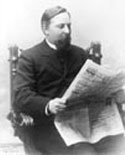The marriage between Helene Gripenberg and John Bergbom lasted for 35 years. From this time in her life we lack sources. In her memoirs that she wrote in 1931, she finishes with stating that she reconnected with her second cousin and married him. “Thus my activities got another direction and my life meaning and worth.” She mentions that John held her dear during their marriage and did his best to even her path as she entered the new household and became lady of the manor. It was no easy task - it required a good sense of organizing. The couple remained childless, which meant that Hertonäs Manor had no heir. Their solution to this problem was to donate the manor to the society Svenska Odlingens Vänner i Helsinge that still manages the manor today.

Helene Bergbom (née Gripenberg, 1851-1932). Photo: SOV.
Helene passed away peacefully on December 15th 1932, but her husband suffered a terrible fate fifteen years earlier. In 1917 Finland was an autonomous part of the Russian Empire and the shortage of food as well as the political uprisings had increased during the ongoing First World War. The labour movement in Finland had become more powerful not only in Finland but also in the rest of Europe. The bad blood between the classes of society, i. e. between the whites (mainly the bourgois and the peasantry) and the reds (mainly the labourers and their supporters), increased. The two Russian revolutions in 1917 also caused more instability. This eventually led to the Finnish Civil War between the reds and the whites, fought in 1918 from January 27th to May 15th. One of the victims of these unstable times was Helene’s husband.

John Bergbom (1850-1917). Photo: SOV.
One morning in November 1917 the old couple sat around the breakfast table on the second floor. Suddenly armed red guards broke into the manor. A short exchange of words between John and the guards ended in the shooting of the old man, who fell to the floor and died on the spot. Helene survived physically unharmed, and later on would only talk about the occasion as “the last terrible blow” in her memoirs. The more exact notes about what actually happened that morning derives from Helene’s brother, Lennart, who has described the happenings in a memorial over John in 1931. According to Lennart John had put his hands in the pockets of his housecoat during the conversation. This had alarmed the guard to think he was grabbing a gun, so they fired a bullet against him and shot him dead.
After the murder Helene moved away from the manor and spent the rest of her life on Luotsikatu in Helsinki. Her brother Lennart and his wife and children lived in the same staircase and Helene spent her last years surrounded by her relatives.
Sources:
Backman, Sigbritt: Hertonäs gård, från säterier till museum, Helsingfors 2016.
Bergbom, Helene: Minnen, Familjeupplaga, 1975.
Morand-Löfving, Elisabeth: Kejserlig uppfostran, finländska flickors skolgång vid Smolna-institutet i S:t Petersburg, Helsingfors 2017.
Translation: EAW.
